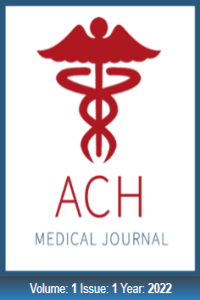Genetic Ethiology, Associated Anomalies in Fetal Aberrant Right Subclavian Artery: A Retrospective Cohort Study in a Tertiary Hospital
Genetic Ethiology, Associated Anomalies in Fetal Aberrant Right Subclavian Artery: A Retrospective Cohort Study in a Tertiary Hospital
Aberrant right subclavian artery, congenital anomalies, fetal, genetic ethiology, ultrasound.,
___
- 1. Zalel Y, Achiron R, Yagel S, Kivilevitch Z. Fetal aberrant right subclavian artery in normal and Down syndrome fetuses. Ultrasound Obstet Gynecol. 2008;31(1):25-9.
- 2. Bravo Arribas C, Gámez Alderete F, Pérez R, Ortiz-Quintana L, de León-Luis J. [Diagnosis of isolated fetal aberrant right subclavian artery]. Ginecol Obstet Mex. 2012;80(6):425-9.
- 3. Polguj M, Chrzanowski Ł, Kasprzak JD, Stefańczyk L, Topol M, Majos A. The aberrant right subclavian artery (arteria lusoria): the morphological and clinical aspects of one of the most important variations--a systematic study of 141 reports. ScientificWorldJournal. 2014;2014:292734.
- 4. Krupiński M, Irzyk M, Moczulski Z, Banyś R, Dwojak I, Urbańczyk-Zawadzka M. CT evaluation of aberrant right subclavian artery: anatomy and clinical implications. Cardiol Young. 2019;29(2):128-32.
- 5. Yates CL, Monaghan KG, Copenheaver D, Retterer K, Scuffins J, Kucera CR, et al. Whole-exome sequencing on deceased fetuses with ultrasound anomalies: expanding our knowledge of genetic disease during fetal development. Genet Med. 2017;19(10):1171-8.
- 6. Scala C, Leone Roberti Maggiore U, Candiani M, Venturini PL, Ferrero S, Greco T, et al. Aberrant right subclavian artery in fetuses with Down syndrome: a systematic review and meta-analysis. Ultrasound Obstet Gynecol. 2015;46(3):266-76.
- 7. Ranzini AC, Hyman F, Jamaer E, van Mieghem T. Aberrant Right Subclavian Artery:Correlation Between Fetal and Neonatal Abnormalities and Abnormal Genetic Screening or Testing. J Ultrasound Med. 2017;36(4):785-90.
- 8. Maya I, Kahana S, Yeshaya J, Tenne T, Yacobson S, Agmon-Fishman I, et al. Chromosomal microarray analysis in fetuses with aberrant right subclavian artery. Ultrasound Obstet Gynecol. 2017;49(3):337-41.
- 9. AIUM practice guideline for the performance of fetal echocardiography. J Ultrasound Med. 2013;32(6):1067-82.
- 10. AIUM Practice Parameter for the Performance of Detailed Second- and Third-Trimester Diagnostic Obstetric Ultrasound Examinations. J Ultrasound Med. 2019;38(12):3093-100.
- 11. Verbitsky M, Westland R, Perez A, Kiryluk K,Liu Q, Krithivasan P, et al. The copy number variation landscape of congenital anomalies of the kidney and urinary tract. Nat Genet. 2019;51(1):117-27.
- 12. Song MJ, Han BH, Kim YH, Yoon SY, Lee YM, Jeon HS, et al. Prenatal diagnosis of aberrant right subclavian artery in an unselected population. Ultrasonography. 2017;36(3):278-83.
- 13. Jelin A, Sagaser K, Lawson C, Forster KR, Leppert K, Hertenstein C, et al. Chromosomal Microarray Analysis Results From Pregnancies With Various Ultrasonographic Anomalies. Obstet Gynecol. 2019;133(4):827-8.
- 14. Ganapathi M, Nahum O, Levy B. Prenatal Diagnosis Using Chromosomal SNP Microarrays. Methods Mol Biol. 2019;1885:187-205.
- 15. Gul A, Corbacioglu A, Bakirci IT,Ceylan Y. Associated anomalies and outcome of fetal aberrant right subclavian ar-
- Başlangıç: 2022
- Yayıncı: Ankara Şehir Hastanesi
Influences on Family Medicine Career Choice: Implications for Healthcare Development
Şeyma Handan DOĞAN, Tarık Eren YILMAZ, Adem ÖZKARA
Nuray YILMAZ ÇAKMAK, Gülay AYDIN, Kadriye KAHVECİ
Silent Pneumoperitoneum in a Major Burn Earthquake Survivor: Sigmoid Diverticular Perforation.
Merve AKIN, Tezcan AKIN, Ayse KARABAĞLI, Ahmet Çınar YASTI
Gökçe Naz KÜÇÜKBAŞ, Nazan AKGÜN KORUK
The Effect of Ticagrelor on Survival of Skin Flap in Rat Model
Mehmet TAPAN, Ali YILDIRIM, Hasan Murat ERGANİ
A Retrospective Analysis of Cases of Non-Immune Hydrops Fetalis in A Tertiary Center
Merve ÖZTÜRK AĞAOĞLU, Atakan TANAÇAN, Zahid AĞAOĞLU, Özgür KARA, Dilek SAHİN
Erhan Renan UÇAROĞLU, Ufuk Turan Kürşat KORMAZ, Yusuf VELİOĞLU, Kemalettin ERDEM
